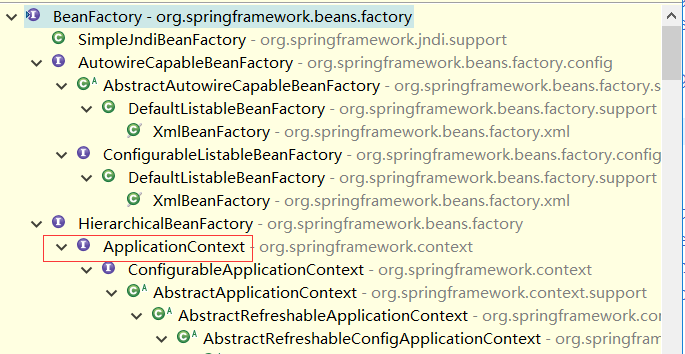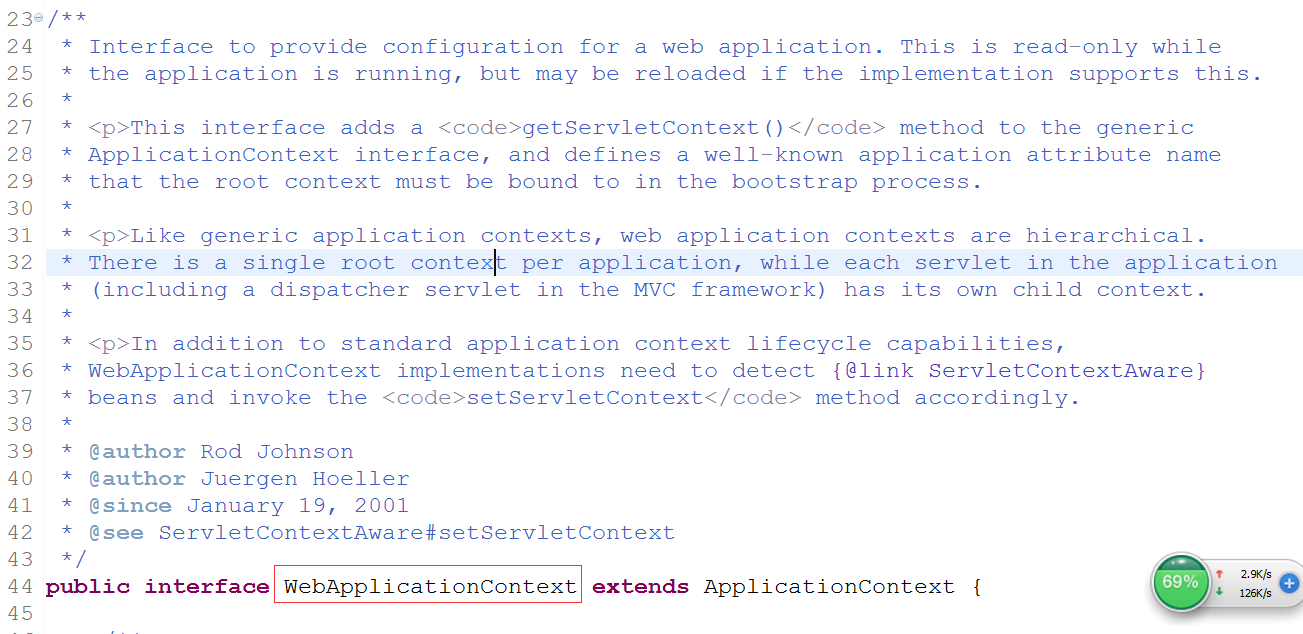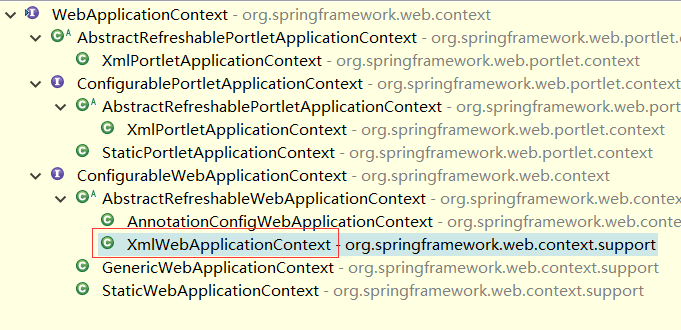1、ApplicationContext的所在的位置如下图

2、WebApplicationContext继承ApplicationContext

3、查看WebApplicationContext的实现类,常用的是XmlWebApplicationContext

XmlWebApplicationContext
/**
* {@link org.springframework.web.context.WebApplicationContext} implementation
* which takes its configuration from XML documents, understood by an
* {@link org.springframework.beans.factory.xml.XmlBeanDefinitionReader}.
* This is essentially the equivalent of
* {@link org.springframework.context.support.AbstractXmlApplicationContext}
* for a web environment.
*
* <p>By default, the configuration will be taken from "/WEB-INF/applicationContext.xml"
* for the root context, and "/WEB-INF/test-servlet.xml" for a context with the namespace
* "test-servlet" (like for a DispatcherServlet instance with the servlet-name "test").
*
* <p>The config location defaults can be overridden via the "contextConfigLocation"
* context-param of {@link org.springframework.web.context.ContextLoader} and servlet
* init-param of {@link org.springframework.web.servlet.FrameworkServlet}. Config locations
* can either denote concrete files like "/WEB-INF/context.xml" or Ant-style patterns
* like "/WEB-INF/*-context.xml" (see {@link org.springframework.util.PathMatcher}
* javadoc for pattern details).
*
* <p>Note: In case of multiple config locations, later bean definitions will
* override ones defined in earlier loaded files. This can be leveraged to
* deliberately override certain bean definitions via an extra XML file.
*
* <p><b>For a WebApplicationContext that reads in a different bean definition format,
* create an analogous subclass of {@link AbstractRefreshableWebApplicationContext}.</b>
* Such a context implementation can be specified as "contextClass" context-param
* for ContextLoader or "contextClass" init-param for FrameworkServlet.
*
* @author Rod Johnson
* @author Juergen Hoeller
* @see #setNamespace
* @see #setConfigLocations
* @see org.springframework.beans.factory.xml.XmlBeanDefinitionReader
* @see org.springframework.web.context.ContextLoader#initWebApplicationContext
* @see org.springframework.web.servlet.FrameworkServlet#initWebApplicationContext
*/
public class XmlWebApplicationContext extends AbstractRefreshableWebApplicationContext {
/** Default config location for the root context */
public static final String DEFAULT_CONFIG_LOCATION = "/WEB-INF/applicationContext.xml";
/** Default prefix for building a config location for a namespace */
public static final String DEFAULT_CONFIG_LOCATION_PREFIX = "/WEB-INF/";
/** Default suffix for building a config location for a namespace */
public static final String DEFAULT_CONFIG_LOCATION_SUFFIX = ".xml";
/**
* Loads the bean definitions via an XmlBeanDefinitionReader.
* @see org.springframework.beans.factory.xml.XmlBeanDefinitionReader
* @see #initBeanDefinitionReader
* @see #loadBeanDefinitions
*/
@Override
protected void loadBeanDefinitions(DefaultListableBeanFactory beanFactory) throws BeansException, IOException {
// Create a new XmlBeanDefinitionReader for the given BeanFactory.
XmlBeanDefinitionReader beanDefinitionReader = new XmlBeanDefinitionReader(beanFactory);
// Configure the bean definition reader with this context's
// resource loading environment.
beanDefinitionReader.setEnvironment(this.getEnvironment());
beanDefinitionReader.setResourceLoader(this);
beanDefinitionReader.setEntityResolver(new ResourceEntityResolver(this));
// Allow a subclass to provide custom initialization of the reader,
// then proceed with actually loading the bean definitions.
initBeanDefinitionReader(beanDefinitionReader);
loadBeanDefinitions(beanDefinitionReader);
}
/**
* Initialize the bean definition reader used for loading the bean
* definitions of this context. Default implementation is empty.
* <p>Can be overridden in subclasses, e.g. for turning off XML validation
* or using a different XmlBeanDefinitionParser implementation.
* @param beanDefinitionReader the bean definition reader used by this context
* @see org.springframework.beans.factory.xml.XmlBeanDefinitionReader#setValidationMode
* @see org.springframework.beans.factory.xml.XmlBeanDefinitionReader#setDocumentReaderClass
*/
protected void initBeanDefinitionReader(XmlBeanDefinitionReader beanDefinitionReader) {
}
/**
* Load the bean definitions with the given XmlBeanDefinitionReader.
* <p>The lifecycle of the bean factory is handled by the refreshBeanFactory method;
* therefore this method is just supposed to load and/or register bean definitions.
* <p>Delegates to a ResourcePatternResolver for resolving location patterns
* into Resource instances.
* @throws java.io.IOException if the required XML document isn't found
* @see #refreshBeanFactory
* @see #getConfigLocations
* @see #getResources
* @see #getResourcePatternResolver
*/
protected void loadBeanDefinitions(XmlBeanDefinitionReader reader) throws IOException {
String[] configLocations = getConfigLocations();
if (configLocations != null) {
for (String configLocation : configLocations) {
reader.loadBeanDefinitions(configLocation);
}
}
}
/**
* The default location for the root context is "/WEB-INF/applicationContext.xml",
* and "/WEB-INF/test-servlet.xml" for a context with the namespace "test-servlet"
* (like for a DispatcherServlet instance with the servlet-name "test").
*/
@Override
protected String[] getDefaultConfigLocations() {
if (getNamespace() != null) {
return new String[] {DEFAULT_CONFIG_LOCATION_PREFIX + getNamespace() + DEFAULT_CONFIG_LOCATION_SUFFIX};
}
else {
return new String[] {DEFAULT_CONFIG_LOCATION};
}
}
}